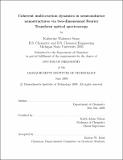Coherent multi-exciton dynamics in semiconductor nanostructures via two-dimensional Fourier transform optical spectroscopy
Author(s)
Stone, Katherine Walowicz
DownloadFull printable version (7.633Mb)
Other Contributors
Massachusetts Institute of Technology. Dept. of Chemistry.
Advisor
Keith A. Nelson.
Terms of use
Metadata
Show full item recordAbstract
The Coulomb correlations between photoexcited charged particles in materials such as photosynthetic complexes, conjugated polymer systems, J-aggregates, and bulk or nanostructured semiconductors produce a hierarchy of collective electronic excitations (i.e. excitons, biexcitons, etc.) which may be harnessed for applications in quantum optics, light-harvesting, or quantum information technologies. These excitations represent correlations among successively greater numbers of electrons and holes, and their associated multiple-quantum coherences could reveal detailed information about complex many-body interactions and dynamics. However, unlike single-quantum coherences involving excitons, multiple-quantum coherences do not radiate and they have largely eluded direct observation and characterization. In this work, I present a novel optical technique, two-quantum two-dimensional Fourier transform optical spectroscopy, which allows direct observation of the dynamics of multiple-exciton states that reflect the correlations of their constituent electrons and holes. The approach is based on closely analogous methods in nuclear magnetic resonance, in which multiple phase-coherent fields are used to drive successive transitions such that multiple-quantum coherences can be accessed and probed. A spatiotemporal femtosecond pulse shaping technique has been used to overcome the challenge of control over multiple, noncollinear phase-coherent optical Fields in the experimental geometries that are used to isolate selected signal contributions through wavevector matching. (cont.) Results from a GaAs quantum well system reveal distinct coherences of biexcitons that are formed from two identical excitons or from two excitons whose holes are in di®erent spin sublevels ("heavy-hole" and "light-hole" excitons). The biexciton binding energies and dephasing dynamics are determined, and changes in the dephasing rates as a function of the excitation density are observed, revealing still higher-order correlations due to exciton-biexciton interactions. Two-quantum coherences due to four-particle correlations that do not involve bound biexciton states but that in°uence the exciton properties are also observed and characterized. I also present one-quantum two-dimensional Fourier transform optical spectroscopy measurements which show that the higher-order correlations isolated by two-quantum techniques are highly convolved with two-particle correlations in the conventional one-quantum measurements.
Description
Thesis (Ph. D.)--Massachusetts Institute of Technology, Dept. of Chemistry, 2009. This electronic version was submitted by the student author. The certified thesis is available in the Institute Archives and Special Collections. Includes bibliographical references (p. 139-149).
Date issued
2009Department
Massachusetts Institute of Technology. Department of ChemistryPublisher
Massachusetts Institute of Technology
Keywords
Chemistry.